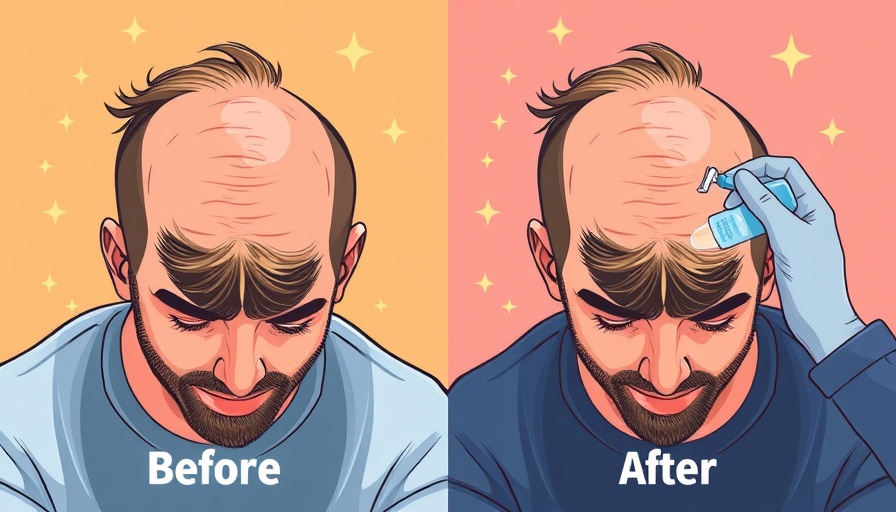
The Science Behind Male Pattern Hair Loss
Understanding why men experience hair loss is critical to navigating treatment options. Male pattern hair loss, known scientifically as androgenetic alopecia, is a common condition that affects millions worldwide. Various factors contribute to this condition, most notably genetics, hormonal changes, and the aging process. It’s essential to recognize that hair loss is a natural biological progression. Even men who maintain a healthy lifestyle may still find themselves grappling with thinning hair as they age. Thus, the search for effective treatments must account for these natural processes while aiming to mitigate their effects.
In 'Hair Loss Treatments For Men (According To Science)', the discussion dives into scientifically proven options for tackling male pattern hair loss, providing insights that sparked deeper analysis on our end.
Common Misconceptions About Hair Loss Treatments
The journey toward finding an effective hair loss solution is often littered with myths and misconceptions. Many individuals believe that over-the-counter supplements or topical shampoos can reverse hair loss biology. However, scientific inquiry reveals that such products generally lack substantial evidence supporting their efficacy. For instance, while some shampoos contain ingredients like caffeine and saw palmetto, rigorous studies often highlight their lack of measurable benefits, primarily due to methodological flaws.
Moreover, it’s crucial to underscore that supplementation should only target underlying deficiencies. In most cases, well-nourished individuals do not face nutrient shortages that contribute to hair loss. Men's reliance on ineffective products can lead to false hope and wasted resources. It's a classic case of buyers beware.
Effective Treatments Backed by Science
For those seeking scientifically validated treatments, minoxidil and finasteride stand out as the most effective options. Both medications represent distinct categories of therapy: minoxidil serves as a hair loss stabilizer, while finasteride functions as an inhibitor of hormone conversion linked to hair follicle miniaturization.
Minoxidil, available in 5% foam or lotion, prolongs the growth phase of hair follicles, significantly affecting those in the early stages of thinning hair. About two-thirds of users experience a halt in hair loss, while 15% report noticeable regrowth. However, this treatment requires long-term commitment, with initial shedding often misleading users into believing it’s ineffective.
Finasteride operates by blocking the formation of dihydrotestosterone (DHT), a hormone playing a major role in hair loss. Clinical data supports finasteride as a front-line treatment, where two-thirds of men see regrowth, and nearly all experience a halt in further loss. However, potential sexual side effects remain a significant concern for many men. Research suggests that while these side effects are rare, they necessitate careful consideration and consultation with healthcare providers.
Combining Treatments for Maximized Benefits
For individuals dealing with more aggressive forms of balding, simultaneously utilizing minoxidil and finasteride may yield superior results. The synergistic effects target both hair stabilization and regrowth more effectively than either treatment alone. Such combinations should ideally be monitored by a specialist, ensuring dosing is tailored to individual needs and minimizing potential side effects.
Advanced Options for Established Hair Loss
In cases of significant hair loss where follicles have become inactive, alternatives such as hair transplant surgery provide a viable solution. Hair transplant techniques involve relocating resilient hair follicles from the back of the head to balding areas, leveraging natural hair growth patterns for a fuller appearance.
For those averse to surgical interventions, camouflage products offer a temporary fix for hair loss. These can range from color sprays to full hair replacement systems—ideal for those seeking immediate cosmetic improvement without undergoing surgical procedures.
Emerging Therapies on the Horizon
The landscape of hair loss treatment is continually evolving. Emerging therapies such as low-level laser therapy and platelet-rich plasma (PRP) have demonstrated potential in clinical settings, sparking interest among researchers and patients alike. While these approaches are promising, further investigation is warranted to confirm efficacy and safety.
As the conversation around male pattern hair loss continues to expand, striking a balance between myth and reality will help men make informed decisions about their treatment options. Consulting with healthcare professionals and basing decisions on reputable scientific findings can pave the way for successful outcomes.
In exploring the various strategies available for managing hair loss, it’s essential for individuals to weigh the pros and cons holistically, factoring in personal values, lifestyle choices, and medical histories to tailor appropriate strategies that suit their needs.
 Add Row
Add Row  Add
Add 




Write A Comment